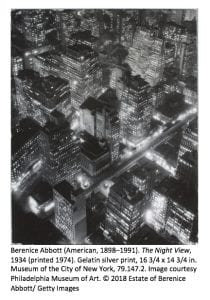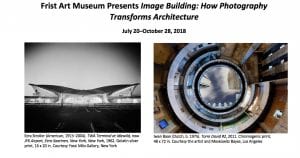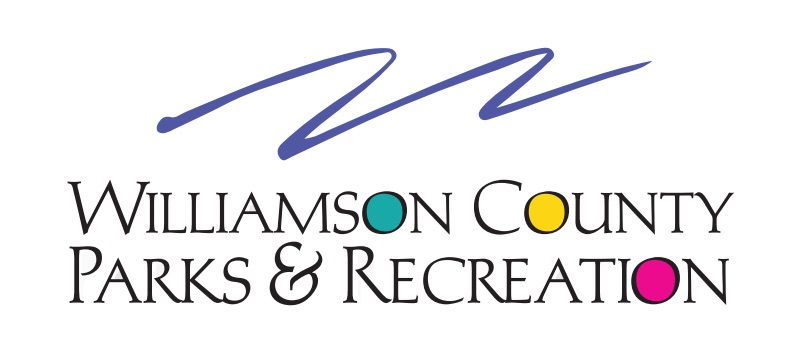Frist Art Museum Presents Image Building: How Photography Transforms Architecture
NASHVILLE, Tenn. (June 12, 2018)—The Frist Art Museum presents Image Building: How Photography Transforms Architecture, an exhibition that examines the complex and dynamic interactions among spectators, images, buildings, and time through the lens of architectural photography in America and Europe from the 1930s to the present. On view in the museum’s Upper-Level Galleries from July 20 through October 28, 2018, Image Building features 57 photographs that explore the social, psychological, and conceptual implications of architecture through the subjective interpretation of those who portrayed it in both film and digital media.
Organized by guest curator Therese Lichtenstein, PhD, Image Building brings together works by 21 artists and commercial photographers, ranging from classic modern masters such as Berenice Abbott, Samuel H. Gottscho, and Julius Shulman to a later generation known for its more vernacular images, with Robert Adams, Lewis Baltz, Luigi Ghirri, and Stephen Shore among its members. The exhibition also features contemporary works by Iwan Baan, Hélène Binet, James Casebere, Thomas Demand, Andreas Gursky, Candida Höfer, Thomas Ruff, Thomas Struth, and Hiroshi Sugimoto, among others.
“Buildings and the way they are photographed are visible projections of a society’s self-image, conveying the social, economic, and aesthetic concerns of an era,” says Frist Art Museum Chief Curator Mark Scala. “Articulating meaning and function through the representation of an existing or possible structure is a vital part of architectural practice—a way to show both clients and the public how buildings fulfill their function and interact with their environments.”
 Organized thematically into Cityscapes, Domestic Spaces, and Public Places, the exhibition examines the relationship between contemporary and historical approaches to photographing buildings in urban, suburban, and rural environments, looking at influences, similarities and differences. By juxtaposing these photographs, Image Building creates a dialogue between the past and present, revealing the ways photography shapes and frames the perception of architecture, and how that perception is transformed over time.
Organized thematically into Cityscapes, Domestic Spaces, and Public Places, the exhibition examines the relationship between contemporary and historical approaches to photographing buildings in urban, suburban, and rural environments, looking at influences, similarities and differences. By juxtaposing these photographs, Image Building creates a dialogue between the past and present, revealing the ways photography shapes and frames the perception of architecture, and how that perception is transformed over time.
In the first section, Cityscapes, the essence of New York City is explored by Berenice Abbott and Iwan Baan in two photographs separated by nearly 80 years. Shot from the vantage point of the Empire State Building, Abbott’s The Night View (1934) is a modernist depiction of a thriving metropolis packed with skyscrapers and shimmering lights. Made during the Great Depression, the photograph shows no hint of the poverty or struggles that many were experiencing at ground level. Contrasting with this message of power and confidence, Iwan Baan’s The City and the Storm (2012) portrays a vulnerable New York after electrical outages and flooding caused by Hurricane Sandy left vast swaths of darkness from lower Manhattan to Midtown.
From the mid-century until now, domestic spaces have presented an irresistible subject to many photographers, who create voyeuristic windows into everyday life, showing elegant modern homes as the beautiful dream of consumerist society, or rundown towns and apartment buildings as loci for alienation and melancholia. The second section, Domestic Spaces, includes photographs of buildings meant for the practical use of individuals and families. People are rarely included in the shots, however. In Julius Schulman’s photographs of show-homes of the post–World War II era, for example, this lack of human presence suggests modern architecture is very much like formalist sculpture—“meant to be looked at in terms of angles, light, planes, but not to be touched, entered, or used,” says Scala. For Shore and others, this human absence tells of a postwar alienation experienced by many in the lower and middle classes who did not benefit from the economic recovery of the 1950s and beyond.
The artists featured in the final section, Public Places, create digital photographs to interpret buildings and sites meant for public use. Monumental works by Andreas Gursky, Candida Höfer, and Thomas Struth show that public places can signify communal aspirations and cultural identity. This extends to architecture that does not actually exist, as seen in the works of James Casebere and Thomas Demand, who photograph models of building types to focus more fully on their symbolic meaning, which is as often unsettling as it is positive.
As with any exhibition that reflects changes wrought through time, Image Building has particular relevance to contemporary culture. Scala hopes that the exhibition will inspire visitors to the Frist Art Museum to consider Nashville’s own evolving cityscape in terms of its symbolic resonance, for us and future generations.
Photographers Represented in the Exhibition
Berenice Abbott (American, 1898–1991), Robert Adams (American, born 1937), Iwan Baan (Dutch, born 1975), Lewis Baltz (American, 1945–2014), Bernd Becher (German 1931–2007), Hilla Becher (German, 1934–2015), Hélène Binet (Swiss-French, born 1959), James Casebere (American, born 1953), Thomas Demand (German, born 1964), Luigi Ghirri (Italian, 1943–1992), Samuel H. Gottscho (American, 1875–1971), Andreas Gursky (German, born 1955), Candida Höfer (German, born 1944), Balthazar Korab (Hungarian, 1926–2013), Thomas Ruff (German, born 1958), Ed Ruscha (American, born 1937), Stephen Shore (American, born 1947), Julius Shulman (American, 1910–2009), Ezra Stoller (American, 1915–2004), Thomas Struth (German, born 1954), and Hiroshi Sugimoto (Japanese, born 1948).
About the Curator
Dr. Therese Lichtenstein organized Twilight Visions: Surrealism, Photography, and Paris for the Frist and is the author of Twilight Visions: Surrealism and Paris (2009). She is the curator and author of Behind Closed Doors: The Art of Hans Bellmer (awarded Best Photography Exhibition of 2001 by the International Association of Art Critics) and Andromeda Hotel: The Art of Joseph Cornell (2006). Dr. Lichtenstein, who received her PhD in art history from The Graduate Center, CUNY, has written articles and reviews for Art in America, Artforum, and Arts Magazine. She taught at Rice University, Mt. Holyoke College, New York University, and the International Center of Photography; and currently teaches art history at the Ross School in East Hampton, New York.
Exhibition Catalogue
Image Building: How Photography Transforms Architecture is accompanied by a 160-page fullyillustrated color catalogue by Therese Lichtenstein, with a foreword and acknowledgments by Parrish Art Museum Director Terrie Sultan and an essay by Marvin Heiferman. Published by DelMonico Books in association with the Parrish Art Museum, it is distributed by DelMonico Books • Prestel.
Exhibition Credit
Organized by the Parrish Art Museum, Water Mill, New York
Image Building: How Photography Transforms Architecture is made possible, in part, by the generous support of the Century Arts Foundation, The Mr. and Mrs. Raymond J. Horowitz Fund for Publications, The Robert Mapplethorpe Foundation, Joseph M. Cohen, Sandy and Stephen Perlbinder, and Lee H. Skolnick Architecture + Design Partnership. Public Funding provided by Suffolk County.
Public Programs
Friday, July 20 Architecture After Photography: A Conversation with
6:30 p.m. Therese Lichtenstein and Susan H. Edwards
Frist Art Museum Auditorium
Free; first come, first seated
Join Image Building curator Therese Lichtenstein and Frist Art Museum executive director and photography scholar Susan H. Edwards for a conversation about how photography shapes and frames the perception of architecture and how that perception is altered over time. Dr. Lichtenstein was the curator of Twilight Visions: Surrealism, Photography, and Paris, which was presented at the Frist in 2009.
Thursday, August 2 Curator’s Tour: Image Building: How Photography
Noon Transforms Architecture
Meet at the exhibition entrance
Free for members; gallery admission required for not-yet-members
A Members-Only Curator’s Tour will be held on Friday, August 3, at noon.
Image Building explores the dynamic relationship between architecture, photography, and the viewer. Join chief curator Mark W. Scala as he examines how the work of modernist and contemporary photographers influence the way we view architecture.
Thursday, August 23 PechaKucha Night, vol. 29
5:30 p.m. presented in partnership with the Nashville Civic
Frist Art Museum Auditorium Design Center
Register at civicdesigncenter.org.
Free to members; $10 general admission (complimentary snacks, wine, and beer [with valid ID] included).
Join us for a PechaKucha Night inspired by Image Building. Hear from architects, designers, and photographers whose work is shaping our urban environment and the future of our city.
The original PechaKucha Night was devised in Tokyo in 2003 as a way for young designers to meet, network, and show their work to the public. It has turned into a massive celebration, with PechaKucha Nights now happening in hundreds of cities around the world, inspiring creatives worldwide. Drawing its name from a Japanese term for the sound of chitchat, its format is simple—20 images x 20 seconds—making presentations concise and moving things along at a rapid pace. Visit civicdesigncenter.org for more details.
Saturday, September 22 Image Building: Downtown Architecture Trolley Tour
11:00 a.m.
Meet at the Frist Art Museum
$10 for members, $12 for not-yet-members
Learn more about the architecture of downtown Nashville on this guided trolley tour, inspired by the exhibition Image Building: How Photography Transforms Architecture. Led by Kem Hinton of Tuck-Hinton Architects and Manuel Zeitlin of Manuel Zeitlin Architects, this one-hour tour will look at Nashville’s changing landscape from the perspectives of history and design.
Visit FristArtMuseum.org to reserve your seat. Registration required by September 17.
Sponsor Acknowledgment
The Frist Art Museum gratefully acknowledges the generosity of our Picasso Circle members.
This exhibition is supported in part by the Metro Nashville Arts Commission, the Tennessee Arts Commission, and the National Endowment for the Arts.
Connect with us! #TheFrist
FOR ADDITIONAL INFORMATION
Buddy Kite: 615.744.3351, bkite@fristartmuseum.org
Ellen Jones Pryor: 615.243.1311, epryor@fristartmuseum.org
About the Frist Art Museum
Accredited by the American Alliance of Museums, the Frist Art Museum is a 501(c)(3) nonprofit art exhibition center dedicated to presenting and originating high-quality exhibitions with related educational programs and community outreach activities. Located at 919 Broadway in downtown Nashville, Tenn., the Frist Art Museum offers the finest visual art from local, regional, national, and international sources in exhibitions that inspire people through art to look at their world in new ways. The Frist Art Museum’s newly renovated Martin ArtQuest Gallery features interactive stations relating to Frist Art Museum exhibitions. Information on accessibility can be found at FristArtMuseum.org/accessibility. Gallery admission is free for visitors 18 and younger and for members; $12 for adults; $9 for seniors and college students with ID; and $7 for active military. College students are admitted free Thursday and Friday evenings (with the exception of Frist Fridays), 5:00–9:00 p.m. Groups of 10 or more can receive discounts with advance reservations by calling 615.744.3247. The galleries, café, and gift shop are open seven days a week: Mondays through Wednesdays, and Saturdays, 10:00 a.m.–5:30 p.m.; Thursdays and Fridays, 10:00 a.m.–9:00 p.m.; and Sundays, 1:00–5:30 p.m., with the café opening at noon. For additional information, call 615.244.3340 or visit FristArtMuseum.org.




